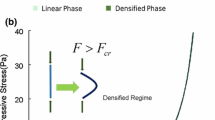Abstract
Fibrinogen is a soluble plasma protein which, after cleavage by the specific proteolytic enzyme thrombin, polymerizes to form the filamentous fibrin network during blood clotting (see refs 1 and 2 for reviews). Fibrinogen has a molecular weight of 340,000 and is composed of two identical halves, each containing three peptide chains designated Aα, Bβ and γ. Fibrin monomers are produced by thrombin which releases the small negatively charged fibrinopeptides A and B. The overall shape of the fibrinogen molecule has not been unequivocally established1,2. The trinodular, elongated (∼450 Å long) structure proposed by Hall and Slayter3 is the most widely accepted model and it has obtained additional support from recent work4–6. Fibrin monomers are also about 450 Å long7 and in fibres they probably have a half-staggered arrangement along the axis7,8. The fibres are an assembly of protofibrils whose structure and packing are not reliably known. We report here that highly oriented fibrin gels are formed when polymerization takes place slowly in a strong magnetic field. It is shown that the protofibrils pack into a three-dimensional crystalline lattice. We introduce magnetically induced birefringence as a potential tool for studying polymerization and briefly speculate on the applications of strong magnetic fields.
Similar content being viewed by others
References
Doolittle, R. F. Adv. Protein Chem. 27, 1–109 (1973).
Doolittle, R. F. in The Plasma Proteins Vol. 2 (ed. Putnam, F. W.) 109–161 (Academic, New York, 1975).
Hall, C. E. & Slayter, H. S. J. biophys. biochem. Cytol. 5, 11–15 (1959).
Fowler, W. E. & Erickson, H. P. J. molec. Biol. 134, 241–249 (1979).
Tooney, N. M. & Cohen, C. J. molec. Biol. 110, 363–385 (1977).
Weisel, J. W., Warren, G. S. & Cohen, C. J. molec. Biol. 126, 159–183 (1978).
Krakow, W., Endres, G. F., Siegel, B. M. & Scheraga, H. A. J. molec. Biol. 71, 95–103 (1972).
Ferry, J. D. Proc. natn. Acad. Sci. U.S.A. 38, 566–569 (1952).
Worcester, D. L. Proc. natn. Acad. Sci. U.S.A. 75, 5475–5477 (1978).
Stryer, L., Cohen, C. & Langridge, R. Nature 197, 793–794 (1963).
Conio, G., Dondero, G., Troglia, C., Trefiletti, V. & Patrone, E. Biopolymers 14, 2363–2372 (1975).
Karges, H. E. & Kühn, K. Eur. J. Biochem. 14, 94–97 (1970).
Hermans, J. Proc. natn. Acad. Sci. U.S.A. 76, 1189–1193 (1979).
Bailey, K., Astbury, W. T. & Rudall, K. M. Nature 151, 716–717 (1943).
Mihalyi, E. Biochim. biophys. Acta 102, 487–499 (1965).
Budzynski, A. Z. Biochim. biophys. Acta 229, 663–671 (1971).
Torbet, J. & Maret, G. Biopolymers (submitted).
Geacintov, N. E., Van Nostrand, R., Pope, M. & Tinkel, J. B. Biochim. biophys. Acta 226, 486–491 (1972).
Saibil, H. R., Chabre, M. & Worcester, D. J. Nature 262, 266–270 (1976).
Neugebauer, D. -Ch., Blaurock, A. E. & Worcester, D.L. FEBS Lett. 78, 31–35 (1977).
Torbet, J. & Maret, G. J. molec. Biol. 134, 843–845 (1979).
Maret, G. et al. in Nonlinear Behaviour of Molecules, Atoms and Ions in Electric, Magnetic or Electromagnetic Fields (Elsevier, Amsterdam, 1979).
Cser, F. J. Phys. théor. appl. 40, 459–470 (1979.
Perplies, E., Ringsdorf, H. & Wendorff, J. H. Polym. Lett. Ed. 13, 243–246 (1975).
Clough, S. B., Blumstein, A. & Hsu, E. C. Macromolecules 9, 123–127 (1976).
Ibel, K. J. appl. Crystallogr. 9, 630–643 (1976).
Author information
Authors and Affiliations
Rights and permissions
About this article
Cite this article
Torbet, J., Freyssinet, JM. & Hudry-Clergeon, G. Oriented fibrin gels formed by polymerization in strong magnetic fields. Nature 289, 91–93 (1981). https://doi.org/10.1038/289091a0
Received:
Accepted:
Issue Date:
DOI: https://doi.org/10.1038/289091a0
- Springer Nature Limited
This article is cited by
-
An anisotropic hydrogel with electrostatic repulsion between cofacially aligned nanosheets
Nature (2015)
-
Thermoresponsive actuation enabled by permittivity switching in an electrostatically anisotropic hydrogel
Nature Materials (2015)
-
Magnetotactic molecular architectures from self-assembly of β-peptide foldamers
Nature Communications (2015)
-
Magnetic responsive scaffolds and magnetic fields in bone repair and regeneration
Frontiers of Materials Science (2014)
-
Super-paramagnetic responsive nanofibrous scaffolds under static magnetic field enhance osteogenesis for bone repair in vivo
Scientific Reports (2013)





